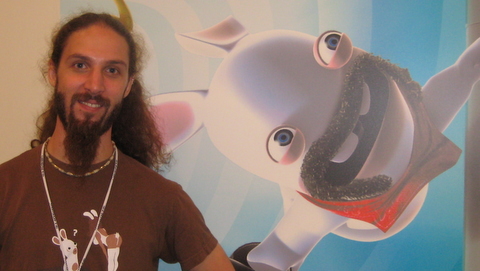When Ubisoft first announced the Rayman: Raving Rabbids for the Wii in 2006, no-one would have foreseen the birth of a massive party game franchise. Being with the Ubisoft Paris team since Raving Rabbids 2, game designer Antione Henry tells Gamesauce about his team’s lucky break to get an extra year of development for their newest title Raving Rabbids: Travel in Time and how that extra year gave his team a chance to reinvent their own party game franchise.

Mixing variety with replayability
According to Henry, the Ubisoft Paris team has significantly shifted their design focus with this latest Rabbids title. “In the previous one, the focus was on variety,” Henry says. “We were aiming for 30 seconds to 1 minute of gameplay for each mini-game.” With Travel in Time the team decided to work deeper gameplay, increasing the average playtime of each mini-game to 3-4 minutes. Instead of having separate control schemes for each of those mini-game like in the previous Rabbids titles, Henry and his team decided to only have 5 different control schemes instead. “So that you can really better at it and build up some experience,” Henry explains. With an average of 5 games for each control scheme, the team decided it would also increase the title’s replayability.

“We wanted to try something else in the party game genre,” Henry admits. “This allowed us to develop different controls and as a designer, it’s a good challenge to have a control scheme that is replayable and people can eventually master.”
Raving Rabbids Reinvented?
Taking a new approach to the franchise, Henry confirms that the Ubisoft Paris team is confident the players will understand the difference in gameplay. “People that bought Raving Rabbids 2 or TV Party, they don’t want to buy the same game over and over again,” he says. “So we’re trying to give them something different as well.”

The early playtesting stages proved the team right. Families, friends, parents and children got to play the Travel in Time prototype. Results showed that testers did not believe they could get any better in several mini-games. “This is not what we wanted of this particular installment of the series,” Henry says. Aside from let players master the mini-games very quickly, Henry and his team improved the game’s design to emphasize the existence of a continuing learning curve.

For Travel in Time, the Paris team also got rid of menus and the user interface. Instead, the player has to wander through a museum to access the various mini-games. When played with more than one player, the museum area becomes a small minigame that teaches the controls to the players. “You don’t have to have that boring tutorial page anymore,” Henry says. “The gameplay itself really has the kind of depth that pushes the player to be better and better.” Additional online challenge modes, leaderboards and Facebook connectivity was also added to get people to master the games even more.
Time to breathe
Having an extra year to develop the game was also a pleasant opportunity for Henry’s team to find the time, experiment introduce all these new design decisions for Travel in Time.
“As Montpellier was developing Rabbids Go Home, that gave our team in Paris an extra year to push our ideas. So as we finished Raving Rabbids 2, we knew we only had one year to get to TV party. But in one year, you don’t get to think, you just do.” With an extra year in their pockets, Henry’s team went back to the drawing board. “We were not going to rush,” he added. “We’re going to put down things and think about what we want to do and how we want to make things different.”
In those two years, Henry’s team took the time to consider how they wanted to carry on with the Rabbids franchise while simultaneously taking the user’s familiarity with the Wii-mote into account. “We do think the massive Wii audience is now getting a bit more experienced at using the controllers,” Henry admits. “So we think we can ask them for a bit more precision, depth and a bit less mindless waggling.”
Raving Rabbids: Travel in Time is currently in development by Ubisoft Paris and has been scheduled for release on November 9, 2010 in North America, and November 11, 2010 in Europe.
Comments













2 comments
Pingback: GoNintendo - Ubisoft offers a different sort of party game with Raving Rabbids Travel in Time
Pingback: Videogame Visionary - Game industry, game studies, game culture. Making sense of it all. » Blog Archive » MONTHLY ARTICLE WRAP-UP
You must log in to post a comment.